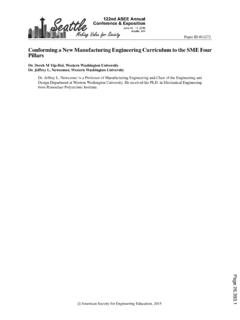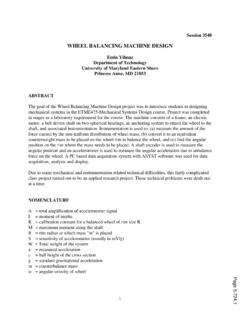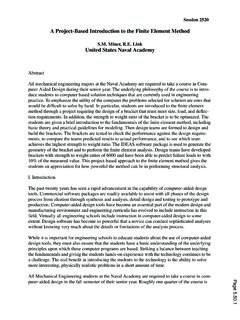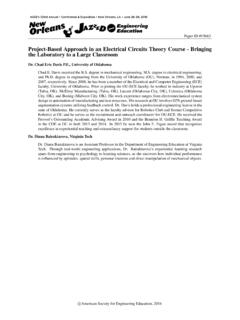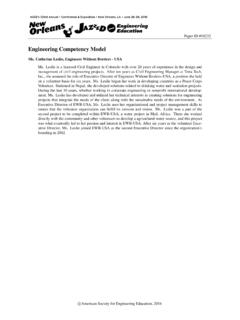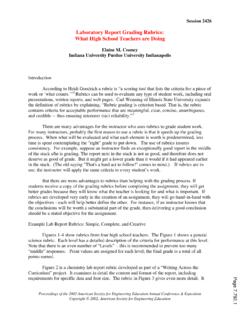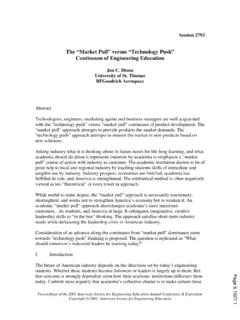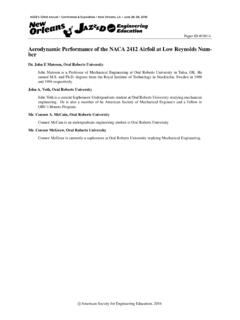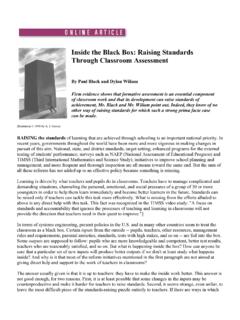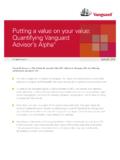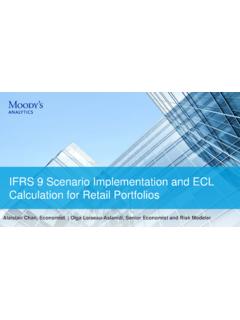Transcription of Engineering Portfolios: Value, Use, and Examples
1 Paper ID #16704 Engineering Portfolios: Value, Use, and ExamplesDr. Vincent Wilczynski, Yale UniversityVincent Wilczynski is the Deputy Dean of the Yale School of Engineering and Applied Science and theJames S. Tyler Director of the Yale Center for Engineering Innovation & Design. As the Deputy Dean,he helps plan and implement all academic initiatives at the School. In addition, he manages the School steaching and research resources and facilities. As the James S. Tyler Director of the Center for Engineer-ing Innovation & Design he leads the School s efforts to promote collaboration, creativity, design andmanufacturing activities at Yale s academic makerspace. His professional interests in Mechanical Engi-neering are in the areas of data acquisition/analysis and mechanical design. He is the Co-Chair of theExecutive Advisory Board of the FIRST Foundation and is a Fellow of the American Society of Mechan-ical Engineering .
2 Previously, he was the Dean of Engineering at the Coast Guard Academy and hashad fellowships at the MIT Charles Stark Draper Laboratory, the Harvard School of Public Health andwith the American Council on Education. He has also served as the Vice President of Public Awareness forthe American Society of Mechanical Engineers and was the 2001 Baccalaureate College Professor of theYear by the Carnegie Foundation, the only national award that recognizes outstanding college Patrick H. Knowles Jr., Cleveland MixerPatrick Knowles has had more than thirty years of increasing responsibilities in Engineering design, engi-neering education, leadership & personnel supervision, financial & project management, and regulatorycompliance. A registered Professional Engineer in Virginia, he recently accepted a position at a manufac-turing firm with duties including Engineering design, Engineering research, and Engineering sales he was the Technologies Department Chair of Three Rivers Community College as well asProfessor in Mechanical and Manufacturing Engineering Technology, and an Associate Professor at Coast Guard Academy in the Mechanical Engineering Section and in the Naval Architecture/MarineEngineering Section.
3 He is a retired Coast Guard officer with twenty years of active duty American Society for Engineering Education, 2016 Engineering Portfolios: Value, Use, and Examples Abstract An Engineering portfolio is a valuable tool when applying to an Engineering position in industry. Web-based portfolios compliment an applicant s r sum and provide insight into an Engineering student s skills as a designer, creator, fabricator, and problem-solver. While the use of professional portfolios is well established in some fields, such as art, film, graphics design, and architecture, the concept is not commonly used within the Engineering disciplines. This paper outlines the value and typical content of an Engineering portfolio . A process to develop an Engineering portfolio will also be presented. The paper will document the efforts of graduate and undergraduate Engineering students to (1) archive professional academic work for display in a portfolio , (2) curate their archived collection to present a concise and cogent display of their professional skills, and (3) organize the portfolio to demonstrate job skills.
4 Introduction Modern communication methods have dramatically changed yet some processes are grounded in the past. One of those processes is the employment application process, in this case for Engineering positions. Typically this process involves an applicant responding to an open position with a cover letter and r sum (or curriculum vitae) often submitted electronically. It is proposed that an Engineering portfolio format allows Engineering students to showcase accomplishments and provides potential employers with greater insight into their competencies and abilities. The material presented in an applicant s professional portfolio may include research findings, artifacts from course work, results from extracurricular activities, and personal endeavors. It is proposed that an applicant with a high quality professional portfolio also has high degrees of creativity, innovation, and initiative, all of which may resonate with future employers and increase their employability competitiveness.
5 This paper examines the history of portfolios in the employment market and in Engineering education, and presents a methodology for undergraduate and graduate students to develop their personal Engineering portfolio . Modeled after approaches used in other creative professions such as art and architecture, the Engineering portfolio is a record of an individual s skills documented by Examples from projects they have worked on. In this context, the Engineering portfolio can be viewed as a tool to demonstrate one s ability to solve Engineering problems. The use of Engineering portfolios as a component of a job application addresses emerging trends in education and business. While the pursuit of an education is primarily an individualistic self-centered activity, employment within an organization is team-based. Also, much of the education process centers on the achievement of objectives (often by demonstrating what an individual knows) while industry focuses on applied problem solving.
6 As such, applicants must shape their internal views of what I can do to align with industry needs of what can you do for our company. The traditional tools of the application process the cover letter and r sum require the employer map the alignment between an individual s skills and the company s requirements. An Engineering portfolio makes this mapping more direct, with the applicant directly aligning Examples of problem solving to the corporate needs. A review of the employer s desirable factors in employees include an ability to work in teams, make decisions, solve problems, plan, organize and prioritize work, analyze quantitative data, and convey results to influence This list of attributes highlight a desire for employees who can do tasks that help the organization, in turn, accomplish its mission. Often this mission involves doing and employers need to find (and hire) doers.
7 An effective Engineering portfolio is an excellent tool to demonstrate an individual s potential contribution to an organization. A similar shift in perspective (from a candidate s focus on what they know to what they have done) is underway within the college admission process. Under the umbrella of a new organization the Coalition for Access, Affordability and Success a new format for college admissions has been developed. In this new system, high school students assemble a portfolio of their experiences as a component of their college application. The portfolios are intended to cover experiences from as early as a student s first year. Students can share their portfolios with teachers, counselors and family members. It is hoped that this group provide advice not only on the portfolio but also on the student s educational trajectory by suggesting courses and activities that will best prepare the students for While the results of this new college application process will play out over the next few years, the students who participate in this process will soon be applying to jobs in industry with the benefit of previously using portfolios as a component of an application.
8 This factor alone signals a need for Engineering educators to become more aware of the value of Engineering portfolios. Engineering Portfolios: History and Applications The portfolio concept has been used within Engineering education in two distinct areas: outcomes assessment and as a tool for employment. Before presenting a methodology for Engineering portfolio development, these areas of application are reviewed. Williams suggests that portfolios of student work can be a valuable tool to document and assess student Principally driven by a need to assess the attainment of communication skills (needed for accreditation purposes), portfolios are presented as a tool to define educational objectives, correlate documented material to a program's educational objectives, facilitate an opportunity for students to reflect on their learning, and assess the attainment of objectives.
9 While the author does not present the mechanics of assembling individual portfolios (over a student's academic career), the author illustrates how portfolios have been used to assess and improve the learning process. Bhattacharya and Hartnett extend the use of student portfolios in Engineering education beyond communications and into all aspects of Engineering professional knowledge and The portfolio serves both as a collection of a student s best work and as a forum to encourage personal reflection. This perspective on portfolios also promotes portfolios as a mechanism that demonstrates the interaction between distinct components of an individual's education. Similar to the newly proposed college admissions portfolios, the Engineering education portfolios can be used with peer review, feedback and improvement. Wilczynski and Colella report on an approach to create institutional portfolio as a tool for programs to use when reviewing the curriculum s ability and performance teaching design The collected information, while useful for structuring course improvements, is also presented as a document to share with accreditation reviewers, benefactors, students and faculty members that illustrates a sequential accumulation of design skills.
10 In this version of the Engineering portfolio , design artifacts from courses throughout the curriculum are documented with the reflection component of the portfolio emphasized as a path for future improvements. This approach is similar to that reported by Kajfez, Kecskemety, and Kross who document how team-based electronic portfolios can be used by design groups to collaborate, share information with others, document the design process, and showcase Examples illustrate how computer models, photographs, and text are combined to produce a team s portfolio . Student surveys document student awareness of the potential benefit of a course-based portfolio when applying for jobs. The concept of Engineering portfolios as a tool to increase an individual s competitiveness for industry jobs has been the subject of other reviews. Estell detailed the creation of interactive programming portfolios as a useful component of a r sum.


